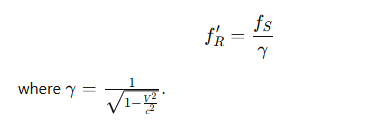15- The relativistic Doppler effect
1/5
Earn XP
Description and Tags
15.2
Name | Mastery | Learn | Test | Matching | Spaced |
|---|
No study sessions yet.
6 Terms
What is the classical Doppler effect equation for sound?
fR is the received frequency
fS is the source frequency
Vair is the speed of sound in air
VR, VS are the velocities of the receiver and source relative to the air.

Why doesn’t the classical Doppler effect apply to light?
Light does not need a medium to propagate, so there is no absolute reference like air.
Instead, special relativity governs the frequency shift.
What is the transverse Doppler shift?
It is the frequency shift observed when a light source moves perpendicularly to the observer's line of sight, caused by time dilation.
How does the transverse Doppler shift differ from the normal Doppler effect?
In the normal Doppler effect, frequency changes due to relative motion along the line of sight.
In the transverse Doppler shift, the change is due to time dilation alone.
What is the equation for the transverse Doppler shift?

What happens to the frequency observed in the transverse Doppler shift?
The observed frequency is lower than the source frequency due to time dilation.